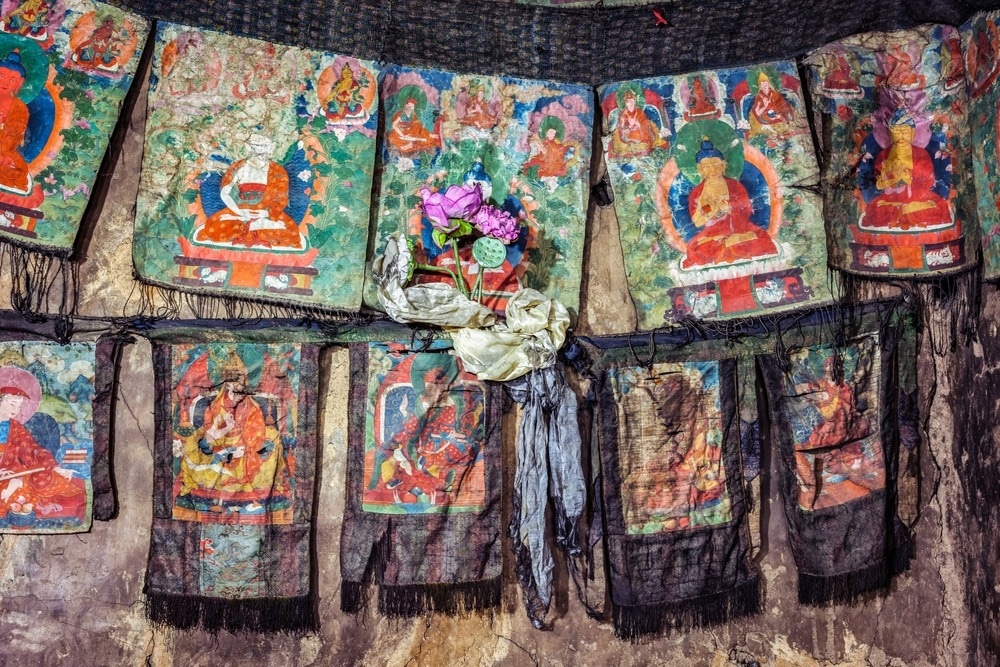Thangkas are sacred artifacts; therefore, conducting scientific examinations of these paintings is not common. Based on this significant ethical challenge, a study published in the journal Heritage proposed a non-invasive three-stage technique that carefully investigates each layer of the painting, successfully assessing various production stages such as color notations, underdrawing, and painting techniques.

Study: Studying Saraha: Technical and Multi-Analytical Investigation of the Painting Materials and Techniques in an 18th Century Tibetan Thangka. Image Credit: Dmitry Rukhlenko/Shutterstock.com
Tibetan Thangka: Sacred Spiritual Paintings
Tibetan thangka is an ancient Buddhist art that emerged in Tibet around the 11th century. Thangka paintings are vertically oriented scrolls made of silk or cotton cloth and are thought to be a meditation and teaching tool for religious academics.
Unfortunately, poor storage and exhibition practices can shorten the life of thangka's paint layer and fabrics.
Scientific Non-Invasive Analysis of Tibetan Thangka
The first thangkas to be investigated primarily using non-invasive methods was 35 thangkas at the Museo Nazionale d'Arte Orientale "Giuseppe Tucci" (MNAO) in Rome.
This systematic study has greatly increased prior knowledge of the materials and techniques employed in thangka paintings. In addition, it provides new insights into the peculiarities of the raw materials used to manufacture colors and their availability in Tibet.
Fiber optic reflectance spectroscopy (FORS) and broadband multispectral imaging (MSI) are two of the most widely available non-invasive techniques that can be incorporated into a multi-analytical protocol to acquire highly visual, spatially, and chemically specific information while also reducing the need for a more significant number of potentially invasive measurements.
Multispectral imaging (MSI)
MSI is well known for its use in analyzing polychrome surfaces and paintings. It has proven to be an effective tool for analyzing delicate instances when limited sampling possibilities are available, such as textiles.
The method is very comprehensive and gives information that non-specialists can easily understand.
Fiber optic reflectance spectroscopy (FORS)
FORS is a fast and non-invasive technique used on textiles and painted surfaces. This technique makes measurements quickly and provides data on the absorption and reflectance features of the materials under investigation.
Technical elements such as color notations, hidden mantras, or underdrawings can be studied using infrared reflectography and X-radiography.
Multi-Analytical Investigation of Thangka Paintings
A multi-analytical technique provided clearer knowledge of the thangka paintings. The primary objective was to gather as much non-invasive information about the artwork as possible while utilizing the least amount of micro-samples necessary for future examination.
A magnified visual inspection was performed to determine the condition of the paintwork. Digital microscopy documented the painting process and underdrawing in great detail.
The different layers of the paintings were examined non-invasively by short-wave infrared (SWIR) reflectography, multispectral imaging (MSI), and X-radiography. However, when further detail was needed, spot measurements of suitable locations were carried out with fiber optic reflectance spectroscopy (FORS).
The similarities between MSI and FORS-observed colored areas enabled a targeted sampling strategy in which a limited number of samples were selected for further examination. Raman spectroscopy and Fourier transform infrared (FTIR) spectroscopy examined these samples and confirmed the identity of missing parameters.
Important Findings of the Study
The proposed three-stage methodology successfully allowed layer-by-layer analysis of the various stages of production of thangka artwork, such as underdrawing, ground preparation, color notations, and palette and painting processes.
The SWIR and infrared-reflected (IRR) images helped comprehend the underdrawing, color notations, and instances of alterations. The infrared-reflected false color (IRRFC), ultraviolet-induced visible luminescence (UVL) and X-ray images provided critical preliminary data on the colorants, the painting technique, and the type of underdrawing.
This imaging phase provided crucial context for what was observed directly and under magnification and laid the foundation for future research.
The Raman, FTIR, and FORS spectroscopies confirmed vital information, such as the identity of pigments, the binder's proteinaceous nature in the green and blue paint, and the identification of kaolinite and magnesite as the white pigment used throughout the composition and in the ground.
Challenges and limitations of the study
The extensive usage of the green and blue copper pigments, malachite and azurite, posed a significant research problem. Particularly in dark green and blue regions, the infrared opacity of these pigments made it extremely difficult to access any potential color notations or underdrawings.
The lack of molecular-level information prevented tracing the colorants, and the origin of the binder was another drawback of using a solely non-invasive approach.
Sampling restrictions and the lack of specialized non-invasive techniques, such as near-infrared FORS and in situ X-ray powder diffraction, did not allow the characterization of the organics and the materials utilized in past conservation interventions.
Despite these obstacles, insightful knowledge was gathered from the analysis of thangka painting, which combines traditional early methods such as the use of lac as a glaze with more modern techniques such as expanding the palette by mixing with white to produce a wide range of green and blue tints for the landscape.
Reference
Dyer, J., Derham, A., O'Flynn, D., Tamburini, D., Heady, T., & Ramos, I. (2022) Studying Saraha: Technical and Multi-Analytical Investigation of the Painting Materials and Techniques in an 18th Century Tibetan Thangka. Heritage. https://www.mdpi.com/2571-9408/5/4/148
Disclaimer: The views expressed here are those of the author expressed in their private capacity and do not necessarily represent the views of AZoM.com Limited T/A AZoNetwork the owner and operator of this website. This disclaimer forms part of the Terms and conditions of use of this website.